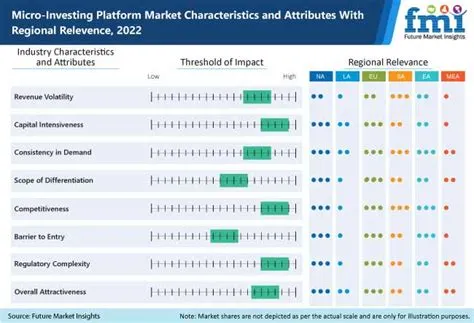Hey there, future investor! Ever feel like you need a million dollars to start investing? Think again! The world of micro-investing-risks">micro-investing-platforms">micro-investing-basics">micro-investing is booming, and it’s making it easier than ever to dip your toes (or even your whole foot!) into the exciting world of finance. But this rapidly evolving landscape isn’t standing still. Competition is fierce, and innovative trends are constantly reshaping how we all approach small-scale investing. Let’s dive into five major competitive trends that are defining the micro-investing industry today.
1. The Rise of Robo-Advisors and AI-Powered Investing
Remember those old-school financial advisors who charged a fortune for their services? Well, the digital age has brought us a much more accessible alternative: robo-advisors. These AI-powered platforms handle your investments for you, often with significantly lower fees. They use sophisticated algorithms to create personalized investment portfolios based on your risk tolerance, financial goals, and investment timeline. It’s like having a personal financial guru in your pocket, without the hefty price tag! This trend is making investing easier than ever for beginners, and the competition among robo-advisors is pushing them to offer increasingly sophisticated features and lower fees, benefiting us all.
Think of it like this: before, investing was like baking a complex cake from scratch – you needed a lot of knowledge and experience. Now, robo-advisors are like pre-made cake mixes – easy to use and still delicious, even if you’re not a professional baker.
2. Gamification and Social Investing
Investing doesn’t have to be boring! A growing number of platforms are gamifying the investment experience, making it fun and engaging for younger generations. Imagine earning badges for reaching investment milestones or competing with friends in friendly investment challenges. This gamified approach is lowering the barrier to entry, turning investing from a daunting task into a playful adventure.
Moreover, social investing is catching on. Platforms allow you to see what your friends, family, and even influencers are investing in, fostering a sense of community and shared learning. This social aspect can be incredibly motivating, and it adds a level of transparency and accountability that wasn’t present in traditional investing.
Is this just a gimmick? Perhaps, but it’s a very effective gimmick that’s getting more people involved in investing – and that’s a win for everyone.
3. fractional shares and Micro-transactions
Remember when you could only buy whole shares of stock? Those days are largely gone! The ability to buy fractional shares – meaning portions of a single share – has revolutionized micro-investing. Now, you can invest in companies like Apple or Amazon even if you only have a few dollars to spare. This accessibility is a game-changer, democratizing the stock market and allowing smaller investors to participate in the growth of major companies.
Micro-transactions further enhance this trend. Platforms allow you to invest small sums of money regularly, even just a few dollars a week. Think of it as automatically setting aside your spare change, only instead of a piggy bank, your spare change is building wealth in the stock market.
4. Focus on ESG (Environmental, Social, and Governance) Investing
More and more investors are prioritizing their values when choosing where to put their money. ESG investing allows you to align your investments with your beliefs, supporting companies that prioritize environmental sustainability, social responsibility, and good governance. This trend isn’t just driven by ethical considerations; it also reflects a growing recognition that ESG factors can significantly impact a company’s long-term performance and profitability.
It’s no longer just about maximizing returns; it’s about investing in a future you believe in. This shift is forcing micro-investing platforms to offer more ESG-focused investment options, reflecting the evolving preferences of their users.
5. Increased Competition and Innovation
The micro-investing space is becoming increasingly crowded. With more and more platforms entering the market, competition is fierce. This intense rivalry benefits investors, leading to lower fees, more innovative features, and improved user experiences. It’s a constant race to offer the best products and services, and the winners will be the platforms that prioritize user satisfaction and financial literacy.
Think of it as a marketplace: more vendors mean lower prices and more choices for the consumer – in this case, you, the investor.
Conclusion
The micro-investing industry is a dynamic landscape, constantly evolving and adapting to the needs of a new generation of investors. The trends we’ve discussed – robo-advisors, gamification, fractional shares, ESG investing, and intense competition – are not just isolated events, but interconnected forces shaping a more accessible, engaging, and socially conscious investing world. If you’ve been hesitant to start investing, now is the perfect time. The tools and resources are more accessible than ever before. Embrace the opportunities and watch your investments grow!
FAQs
1. Are micro-investing platforms safe? Reputable platforms utilize robust security measures to protect your investments. However, always do your research and choose a platform with a strong track record and positive user reviews.
2. What are the risks associated with micro-investing? As with any investment, there are risks involved, including market volatility and the potential for losses. It’s crucial to understand your risk tolerance and diversify your investments.
3. How much money do I need to start micro-investing? Many platforms allow you to start with as little as a few dollars, making it accessible to almost everyone.
4. How can I choose the right micro-investing platform for me? Consider factors like fees, investment options, user interface, security measures, and customer support when selecting a platform. Read reviews and compare different options before making a decision.
5. Can I withdraw my money anytime? Withdrawal policies vary between platforms, so it’s important to check the terms and conditions of your chosen platform before investing.

